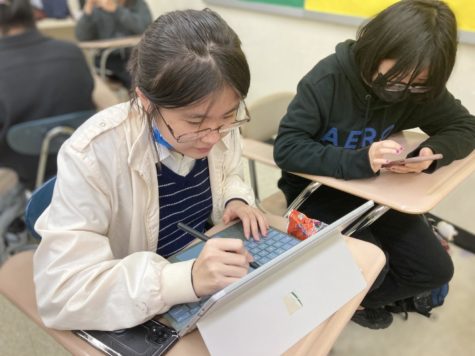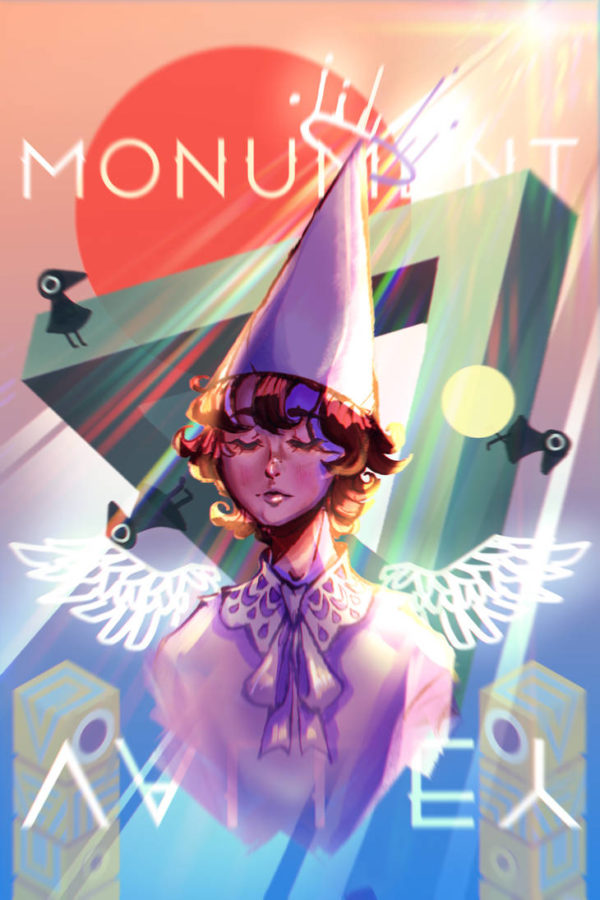Art, Community, and Everything in Between: A Profile of the Digital Arts Club
From a small Friday hangout group to a dedicated family of artists, the Bronx Science Digital Art Club has certainly come a long way.
‘Monument Valley’ by Elisa Oh ’26 is a recent piece that she completed, and Oh looks forward to creating more digital art in the DAC community.
The room was quiet with suspense and excitement as we waited for Mr. Gonzowitz, our club’s faculty advisor, to arrive. Garfield-themed decorations (in honor of the club’s “mascot”) hung around the classroom, creating a beautifully unified party setup.
The ornaments of the familiar cartoon character serve as a reminder that the club does not strive for perfection, and students do not have to be masters of art to join. Rather, they can enjoy the relaxed and casual nature of the club, similar to the traits of the cartoon cat Garfield.
When Mr. Gonzowitz finally stepped through the door, we all cried out, “Happy pseudo-birthday!”
A pizza party and ceremonial tiara crowning of Mr. Gonzowitz followed, with everyone enjoying the celebration and giving each other presents, which were Garfield-related of course.
This was the Digital Arts Club, or the DAC, on Friday, March 13th, 2022 after a day of classes ended at Bronx Science.
The President of the 2021-2022 school year, Alexandria Wang ’22, had spontaneously asked members to come to help prepare the classroom and make original works of art to give to our wonderful advisor. Despite the coming joyous occasion, we had been worried, as there appeared to have been a decrease in student interest in the club. Weekly attendance had declined, and even a part of the club board seemed to have given up on the DAC, making it difficult to predict the outcome of our efforts.
In the months leading up to the party, the club felt disconnected at times, and as a result, meetings became sparsely attended as well. This feeling of the end of an era was exactly why the pseudo-birthday party will always be one of my favorite memories of the club.
The genuine joy we felt celebrating seemed to manifest itself as an omen, signaling that there was more to come: the DAC had not run out of steam yet.
In fact, after I advertised the DAC during the September 22nd, 2022 Club Fair, as the Co-Vice President, alongside President Maria Gil ’23, Co-Vice President Fairooz Tahsin ’24, and Secretary Mariam Samake ’24, the DAC is seeing a major influx of interested students during the current 2022-2023 academic year, more than ever before, marking a promising future for the small-scaled club.
However, while the club is evolving, the DAC is, and always will be, a welcoming place for all art enjoyers, even those just dipping their feet into the digital art waters.
The rise of youth interested in digital art reflects a greater phenomenon beyond the grounds of Bronx Science. The surge of digital art in recent years has been exponential, with a 2021 Hiscox Online Art Trade Report finding that 84% of art buyers believe that the art market is shifting permanently to digital.
With the rise of social media, coupled with the COVID-19 pandemic, it is not surprising for many, especially the young, to turn to more convenient methods of making art. Living remotely prompted many of the younger generations to turn to art apps and programs on digital devices, which provide a wide variety of tools to create art. Compared to continuously buying different traditional art supplies, the transition to digital art seemed like the logical next step for young artists who are open to change.
At its core, digital art, like any medium of art, is meant to be a fun, creative outlet for artists to express themselves. By making an enjoyable hobby more convenient, digital art software allows artists to have a multitude of different tools ready at their fingertips.
The benefits of digital art are not only limited to the capabilities within the apps but also extend to the apps themselves. From professional software like Adobe Photoshop to free apps like Ibis Paint X (which includes phenomenal features at no cost), digital art apps offer invaluable convenience in choosing from options.
A single app contains vast arrays of brushes that can be switched — or even altered in attributes including texture, jitter, and shape of the brush — in an instant. This not only saves artists time from buying and manually switching between setups and tools to work but also makes creating art more enjoyable. Artists can experiment with art styles by changing brushes, or they can easily organize their pieces with features that would otherwise be difficult to achieve in traditional art, like the use of layers. This is especially helpful when working on large and convoluted projects by ensuring different parts of the piece are accessible and convenient to change.
The quality-of-life utilities of digital art are appealing to many younger generations of artists, explaining why there has been such a great increase in new members in the Digital Arts Club. With new members come new changes, which the DAC board has begun to implement this year.
One such change is providing club members with more opportunities to gain recognition for their art. These included competitions that members can enter; by working on these contests together, members can form closer relationships with each other.
Club secretary Mariam Samake ’24 researches international art competitions to present club members with opportunities to share and expose their art to others. “I’m looking forward to the new events we have planned for this year,” Samake said. “I’m hoping our members will get to know each other more through these and will find other ways to have fun in the club.”

Since ninth graders make up the majority of the members this year, the DAC acts as an opportunity for them to make new friends and adjust to Bronx Science together. With a common link of interest in digital art, members can attend meetings and develop social connections by working together during group activities.
This way, members can enjoy creating art, as well as form bonds with each other that can last throughout their time at Bronx Science, and even after high school. “I think the thing I look forward to most this year in DAC is being able to talk and collaborate with new people. Visual art has never failed to fascinate me, and I really hope that I get to share my passion for it with others!” said Vienna Chen ’26.
Another improvement the DAC board is implementing this year is the integration of free drawing and some more structured lessons during meetings.
Fridays are usually times when students want to relax, which is why the DAC leadership allows members to have free-drawing sessions. There are also beginners in the club, so the board plans to teach members who want help. The board also has knowledge pertaining to how to use different digital art software, like Photoshop and Krita, and can teach helpful tips and tricks to members.
This sentiment is crucial to helping the DAC prosper, as the club’s members are immersed in a community that is working together to grow as a whole.
“I’m most looking forward to seeing people’s art skills improve as the year goes on!” Maria Gil ’23, President of the DAC said. “Hopefully, people will be more motivated to draw if they can do so with their club friends, and drawing a lot while implementing the digital art fundamentals we learn is a great way to get better at the craft.”
“I’ve seen us gain amazing new members, but I am really excited about the new leadership,” Mr. Gonzowitz said. “Their energy is amazing, and they really care about seeing the club become what was envisioned, a place to share art, compete, and grow.”
As the DAC continues to grow, it takes its members along on its journey. With the inconsistent attendance of members of the club last year, doubts about the DAC’s posterity seemed to loom over the atmosphere of the club. Now during the 2022-2023 school year, a new wave of students is interested in digital art, both on the local and global scale.
From the day former President Alexandria Wang ’22 hosted Mr. Gonzowitz’s pseudo-birthday, I saw another spark of enthusiasm paralleling that of when I first joined the club last year. With the support of the DAC members, the board of the 2022-2023 school hopes to leave each year off better than the last.
The club’s growth over the past years has been astonishing, and its future seems to brim with potential. The Garfield-like splendor of the DAC will continue to attract students in a school of rigorous and STEM-focused courses, creating a haven for those who enjoy and appreciate digital artistry.
“I’ve seen us gain amazing new members, but I am really excited about the new leadership,” Mr. Gonzowitz said. “Their energy is amazing, and they really care about seeing the club become what was envisioned, a place to share art, compete, and grow.”
Katherine Han is a Copy Chief for ‘The Science Survey.’ She enjoys how journalistic writing serves as a channel of knowledge and medium for experimentation...











